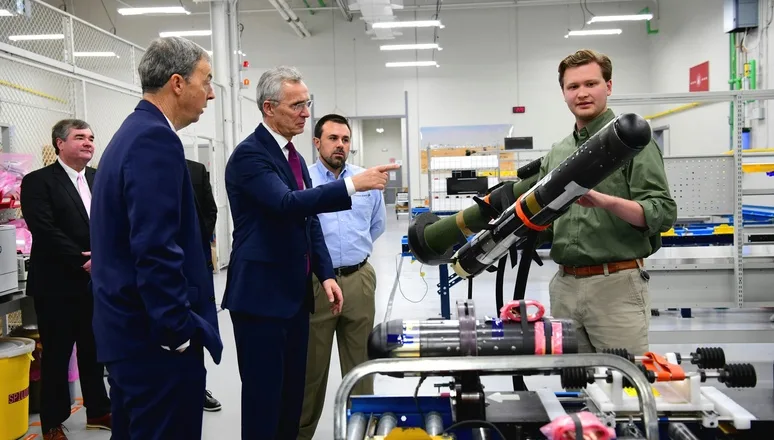
The escalating technological race between China and the United States is substantially reshaping geopolitics at global level, transgressing economic and innovative domains. It exemplifies intricate network of global interdependency also having geopolitical ramifications spilling over across regions. Inside the North Atlantic Treaty Organization (NATO), while the direct engagement in the US-China tech war might not be immediately apparent, the indirect implications are observable and require instantaneous and systematic consideration. NATO’s expansion seems not to be limiting to the European Theatre only; its outreach expands to the East Asian allies of the US as well. NATO also plans a liaison office in Japan while Japan is pushed to assist in weaponsiation of Poland which further extends the integrated deterrence framework, diluting regional demarcations of alliances.
“The continuous rise in global military expenditure in recent years signals a growing sense of insecurity,” noted Dr. Nan Tian, Senior Researcher at SIPRI’s Military Expenditure and Arms Production Programme. SIPRI notes a notable increase in European defence spendings since Cold War. The head of the European Defence Agency (EDA), Josep Borrell cautioned about the ‘key capability gaps’ in the European defence responsible for Europe lagging behind in great powers hierarchy. As noted by IISS in ‘The Military balance 2024,’ Western strategy updates significantly recognize China as a serious concern parallel to Russia. Germany identifies its relationship with China involving as a ‘partner, competitor, and systemic rival.’ Similarly, Australia and also New Zealand highlight concerns over concealment in China’s defense planning, advanced weaponisation, expansion of its nuclear arsenals, naval modernization and consequently stress regional security frameworks.
Central to this particular issue is the growing nexus of modern warfare and the advanced technology, extending critical domains including telecommunications infrastructure alongside unmanned aerial vehicles (UAVs) – the drones, air- and missile-defence capabilities. In the course of escalating US-China tech warfare, both states have been aggressively seeking to reduce their reciprocal dependency on certain critical technologies, particularly semiconductors, telecom equipment, and drone technology. The drive for technological autonomy has triggered a restructuring of global technological supply chains, as states like the US and China aim to strengthen national capabilities and also diversify supplier options. In consequence, Europe emerges to the forefront as a critically contested theatre as the US and China vie for and strengthening alliances-cum-partnerships to propel their technological imperatives, incorporating advancing and strengthening technology, particularly drones, for both civilian and military use.
The ramifications of this technological rivalry reflect throughout Europe, wherein leaders have been bargaining with their imperative of insisting significant technological sovereignty, specifically in drone technology. Concerns pertaining to overreliance on technology imports, primarily sourced from the US and China, have prompted initiatives aimed at fostering indigenous European technological innovation and enhancing Europe’s competitiveness in crucial technological sectors of warfare like the drone manufacturing as well as deployment. In addition to drones and telecommunications, Chinese advancements extend in crucial domains that include blockchain technologies, semiconductors and also artificial intelligence and it demonstrates Chinese penetration into strategic industries. These developments along with increasing reliability crisis of the US extended deterrence amid Ukrainian Conflict is perceived by Europe as a necessity for indigenous weaponisation The European focus to develop drone technology is to strengthen their capability for surveillance, reconnaissance, and military applications amid increasingly tenuous state of strategic stability in the region. Additionally, the technological competition, notably in the domains of cyber security and the 5G infrastructure, increases the challenges confronting Europe. Europe is actively strengthening retaliatory measures to guard cybersecurity and enacting stricter laws to secure critical infrastructure from any possible vulnerabilities, thereby underscoring the European concerns associated with emerging technologies, and tech race as a byproduct of the US-China rivalry.
The escalating rivalry between the US and China places Europe in a strategy dilemma between the US and China whereby maintaining a delicate equilibrium, though necessary, also compromises strategic security umbrella so far enjoyed by the US allies under the NATO allegiance. Since balancing economic relations with security risks emanating from advanced tech race necessitates delicate equilibrium in European foreign policy, it would also delineate the extent to which the European states would be allowed to exercise autonomy in the emerging multipolar order. Nevertheless, this drive for autonomy in such critically advanced warfare tech carries integral risks. In efforts to limit its dependency and bargain its autonomy, Europe might, though inadvertently, contribute to augmented militarized approach by weaponisation of technological development aimed at strengthening military capabilities, as in the drone sector, which potentially contributes to escalation of already prevalent security tensions.
The US-China Tech Race bears Liability for Weaponisation of NATO where Europe is reassessing its military capabilities and defense strategies. European states are ramping up their defense spending with added investments in emerging technologies such as autonomous systems and drone swarms, and also AI. It is an attempt to strengthen their military posture in a cautious strategic response to evolving European security dynamics particularly at a time when Russia is already challenging credibility of the European deterrence framework through Ukraine Conflict.
